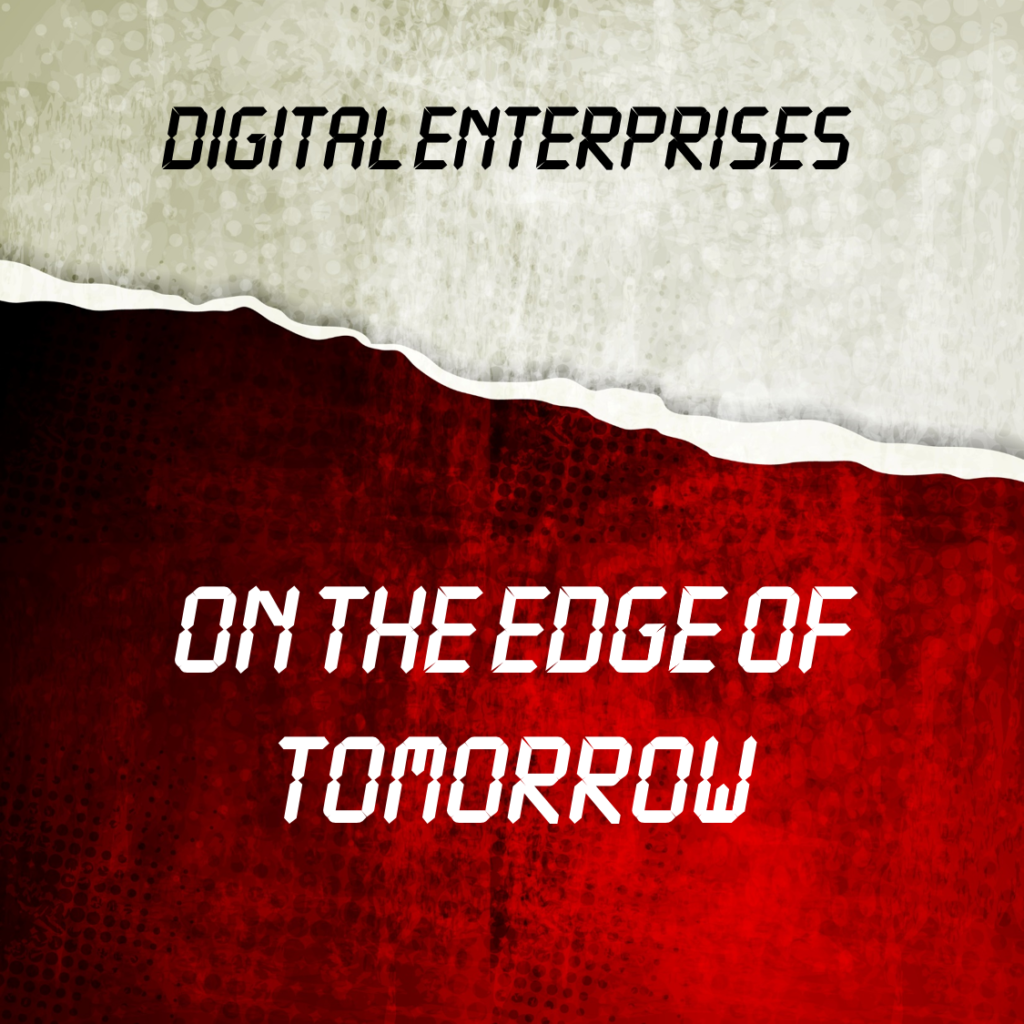A few years ago, Tom Cruise and Emily Blunt starred in a science fiction film entitled “Edge of Tomorrow.” The marketing tagline for the movie was “Live. Die. Repeat.” In the film Cruise and Blunt are trying to defeat alien invaders and find themselves in a time loop that allows them to gradually improve their fighting skills and slowly progress towards their objective. In each loop, they end up dying, only to reanimate and find themselves at the start of the same scenario. Once they realize they are in a time loop, they begin to use this knowledge to their advantage. You might say it’s an action-filled “Groundhog Day” movie. In real life, companies can’t live on the edge of tomorrow repeatedly dying and returning to life as they try to improve their business model. Generally, you only get one chance to get it right. Why is this a concern? Because many businesses are poised on the edge of tomorrow and the last thing they want to do is slide over the edge into an unknown abyss. How do they avoid such a fate? Business executives leading organizations designed around Industrial Age principles are being told they need to transform their organizations into digital enterprises.
The digital transformation imperative
Some business leaders are understandably reluctant to change business practices (or business models) that have served their companies well for decades. The old phrase “if it ain’t broke, don’t fix it” comes to mind. So does the phrase, “Change or be left behind.” Nitin Seth (@seth_nitin), CEO of Incedo, believes most executives have come to the realization that the business environment has changed so significantly their organizations must change or die. He explains, “In a world of constant and extensive technology disruption, with organizations engaged in a battle for survival, the urgency to digitally transform is well understood by almost every large enterprise.”[1] Even if business leaders feel a sense of urgency, they also feel a bit of anxiety. Many of them aren’t sure exactly what digital transformation means. Mark van Rijmenam (@VanRijmenam), founder of Datafloq, asserts understanding digital transformation begins with a recognition that tomorrow’s enterprises will rely heavily on data. He explains, “The organization of tomorrow will be built around data. Therefore, the first step is to datafy your organization and collect data at every process and customer touchpoint. The second step in the organization of tomorrow is to distribute that data. Either using centralized databases in the cloud or decentralized databases using distributed ledger technology. The third step is to analyze the data. This will enable you to find patterns and make sense of it. The final step in building the organization of tomorrow is to automate it using AI. This will enable you to leverage the data and embed smartness in every process and customer touchpoint.”[2]
If you are not convinced a digital transformation imperative exists, Seth offers six reasons for you to reconsider. They are:
1. Customer behavior is changing: Seth explains, “Today’s digital customers are younger, more fickle and typically in the 18-35 ‘millennial’ demographic. They are not only active on social media but also greatly influenced by peers and brands they follow across various platforms like Twitter, Facebook, Instagram and Snapchat.”
2. Big data is exploding: “The volume, velocity and variety of data,” Seth writes, “is unprecedented and will continue to grow exponentially, especially for digital businesses.”
3. The velocity of change is accelerating: Seth insists, “The velocity of change has increased on all fronts. Technologies from a few years ago like cloud and mobile have become commonplace and have been replaced by newer technologies like artificial intelligence, the Internet of Things and blockchain, which are driving current conversations.”
4. Technology is changing business models: Seth explains, “Technology started off as a support function that ran company servers and data centers. Over the past decade or so, it has progressed to being an enabler, which would build and maintain the applications that ran businesses. Today technology is front and center, meaning a digital business is a technology business.”
5. Digital transformation is a journey not a destination: Seth writes, “Digital transformation [is] a continuously moving target requiring an iterative approach.” It’s not a destination because “customers have ever-evolving needs, analytics are constantly improving,” and “digital technologies enable continuous deployment.” He concludes, “Continuous experimentation and learning is the key.” That’s a different approach than “live, die, repeat.” At Enterra Solutions®, we call it a “crawl, walk, run” approach. McKinsey & Company analysts, Tanguy Catlin, Laura LaBerge, and Shannon Varney, assert strategy approaches and implementation approaches aren’t the same thing. “If there’s one thing a digital strategy can’t be,” they write, “it’s incremental. The mismatch between most incumbents’ business models and digital futures is too great — and the environment is changing too quickly — for anything but bold, inventive strategic plans to work.”[3]
6. A holistic approach is required: Seth writes, “When it comes to building a digital business, the problem is not simply about marketing, finance, operations or technology; digital problems are interdisciplinary.”
Winning the digital transformation battle
James Houghton, Vice President at Cognizant Digital Technology Consulting, reports, “In a recent study, top executives across industries cited three of their biggest obstacles to achieving digital transformation. While agreement on what digital really means may seem like the biggest obstacle, more than half said organizational restructuring and resistance to change were their top two obstacles, and nearly 40 percent cited the lack of key digital skills.”[4] In order to improve the chances for digital transformation success, Houghton insists, “Building a solid foundation to support digital is a critical first step.” Catlin, LaBerge, and Varney, believe business executives must win four fights to obtain the necessary support. Those fights are:
1. Fighting ignorance. They explain, “Many senior executives aren’t fully fluent in what digital is, much less up to speed on the ways it can change how their businesses operate or the competitive context. That’s problematic. Executives who aren’t conversant with digital are much more likely to fall prey to the ‘shiny object’ syndrome: investing in cool digital technologies (which might only be relevant for other businesses) without a clear understanding of how they will generate value in the executives’ own business models.”
2. Fighting fear. “Getting left behind by digital first movers can be hazardous to your company’s future,” they write. “But many of your executives may perceive responding to digital — making the big bets, building new businesses, shifting resources away from old ones — as hazardous to their own future.”
3. Fighting guesswork. As I noted earlier, executives on the edge of tomorrow often only see an abyss into which they can fall. Catlin, LaBerge, and Varney, explain, “Pursuing an aggressive digital strategy involves leaps into the unknown: simultaneously, you are likely to be moving into new areas and overhauling existing businesses with new technologies. What’s more, in many digital markets, the premium of being a first mover makes it necessary not only to shift direction but also to do so faster than your peers. The combination of ambiguity and the need for speed sometimes gives rise to guesswork and moves that are hasty or poorly thought out — and to anxiety about whether a move isn’t going to work or just needs more time.”
4. Fighting diffusion. Catlin, LaBerge, and Varney, write, “Effective strategy requires focus, but responding to digital inevitably risks diffusion of effort, or ‘spreading the peanut butter too thinly.’ Most companies we know are trying, and struggling, to do two things at once: to reinvent the core by digitizing and automating some of its key elements, for example, and to create innovative new digital businesses. The challenge is acute because of the dizzying pace of digital change and the uncertainty surrounding the adoption of new technology.”
Catlin, LaBerge, and Varney, offer suggestions about how to win each of these fights and I highly recommend you read their full article. Houghton also offers suggestions about how to overcome challenges to digital transformation. He concludes, “The process of digital transformation is not easy, but addressing these key barriers can help you overcome the challenges and build a digital transformation strategy that improves your business operations and increases revenues.” Businesses need not sit poised on the edge of tomorrow worrying about falling into the abyss. There are steps they can safely follow as they transform.
Footnotes
[1] Nitin Seth, “Six Reasons Why Digital Demands A New Business Paradigm,” Forbes, 19 October 2018.
[2] Mark van Rijmenam, “How to Build the Organisation of Tomorrow?” LinkedIn, 17 October 2018.
[3] Tanguy Catlin, Laura LaBerge, and Shannon Varney, “Digital strategy: The four fights you have to win,” McKinsey Quarterly, October 2018.
[4] James Houghton, “Overcoming the top obstacles to digital transformation success,” Information Management, 10 October 2018.





